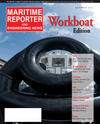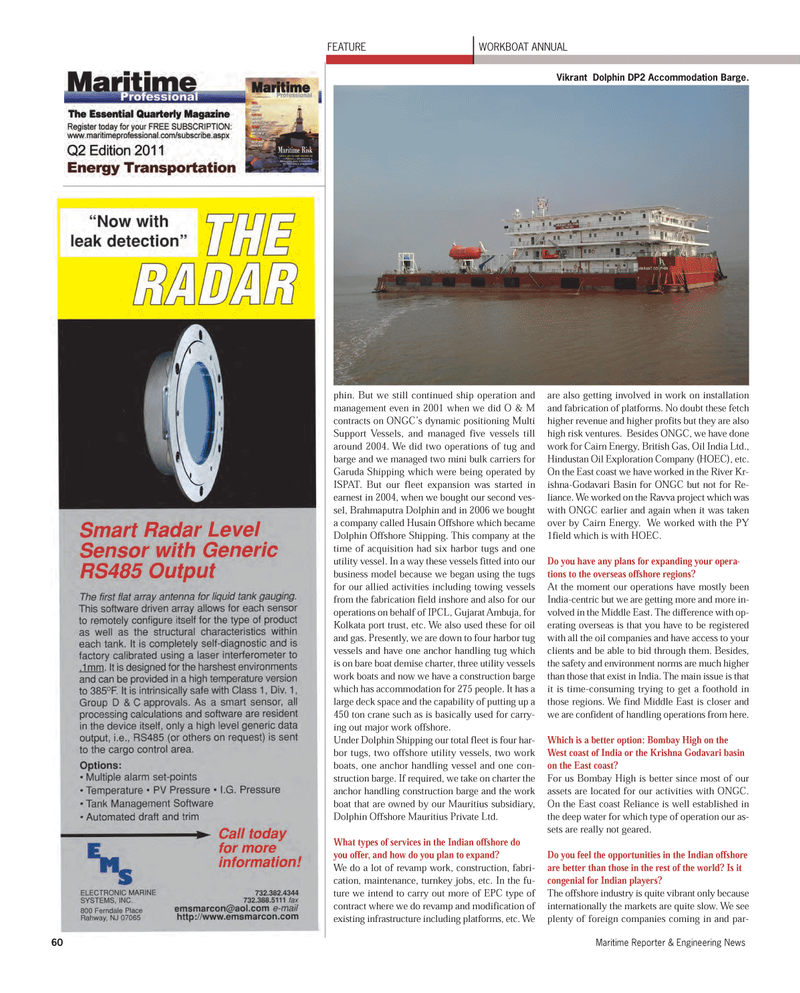
Page 60: of Maritime Reporter Magazine (November 2011)
Feature: Workboat Annual
Read this page in Pdf, Flash or Html5 edition of November 2011 Maritime Reporter Magazine
phin. But we still continued ship operation andmanagement even in 2001 when we did O & M contracts on ONGC?s dynamic positioning Multi Support Vessels, and managed five vessels till around 2004. We did two operations of tug and barge and we managed two mini bulk carriers for Garuda Shipping which were being operated byISPAT. But our fleet expansion was started in earnest in 2004, when we bought our second ves- sel, Brahmaputra Dolphin and in 2006 we boughta company called Husain Offshore which became Dolphin Offshore Shipping. This company at the time of acquisition had six harbor tugs and oneutility vessel. In a way these vessels fitted into our business model because we began using the tugs for our allied activities including towing vessels from the fabrication field inshore and also for our operations on behalf of IPCL, Gujarat Ambuja, for Kolkata port trust, etc. We also used these for oil and gas. Presently, we are down to four harbor tug vessels and have one anchor handling tug which is on bare boat demise charter, three utility vessels work boats and now we have a construction barge which has accommodation for 275 people. It has alarge deck space and the capability of putting up a 450 ton crane such as is basically used for carry- ing out major work offshore. Under Dolphin Shipping our total fleet is four har- bor tugs, two offshore utility vessels, two work boats, one anchor handling vessel and one con- struction barge. If required, we take on charter the anchor handling construction barge and the work boat that are owned by our Mauritius subsidiary, Dolphin Offshore Mauritius Private Ltd. What types of services in the Indian offshore do you offer, and how do you plan to expand? We do a lot of revamp work, construction, fabri- cation, maintenance, turnkey jobs, etc. In the fu- ture we intend to carry out more of EPC type ofcontract where we do revamp and modification of existing infrastructure including platforms, etc. We are also getting involved in work on installation and fabrication of platforms. No doubt these fetch higher revenue and higher profits but they are also high risk ventures. Besides ONGC, we have done work for Cairn Energy, British Gas, Oil India Ltd., Hindustan Oil Exploration Company (HOEC), etc. On the East coast we have worked in the River Kr- ishna-Godavari Basin for ONGC but not for Re- liance. We worked on the Ravva project which was with ONGC earlier and again when it was taken over by Cairn Energy. We worked with the PY 1field which is with HOEC. Do you have any plans for expanding your opera- tions to the overseas offshore regions? At the moment our operations have mostly been India-centric but we are getting more and more in- volved in the Middle East. The difference with op- erating overseas is that you have to be registered with all the oil companies and have access to your clients and be able to bid through them. Besides,the safety and environment norms are much higher than those that exist in India. The main issue is that it is time-consuming trying to get a foothold inthose regions. We find Middle East is closer and we are confident of handling operations from here. Which is a better option: Bombay High on theWest coast of India or the Krishna Godavari basin on the East coast? For us Bombay High is better since most of our assets are located for our activities with ONGC. On the East coast Reliance is well established inthe deep water for which type of operation our as- sets are really not geared. Do you feel the opportunities in the Indian offshore are better than those in the rest of the world? Is it congenial for Indian players? The offshore industry is quite vibrant only because internationally the markets are quite slow. We see plenty of foreign companies coming in and par- 60Maritime Reporter & Engineering News FEATURE WORKBOAT ANNUAL Vikrant Dolphin DP2 Accommodation Barge. MR Nov.11 # 8 (57-64):MR Template 11/2/2011 1:46 PM Page 60

 59
59

 61
61
